1lumen selects and reviews products personally. We may earn affiliate commissions through our links, which help support our testing.
Fenix E35R review
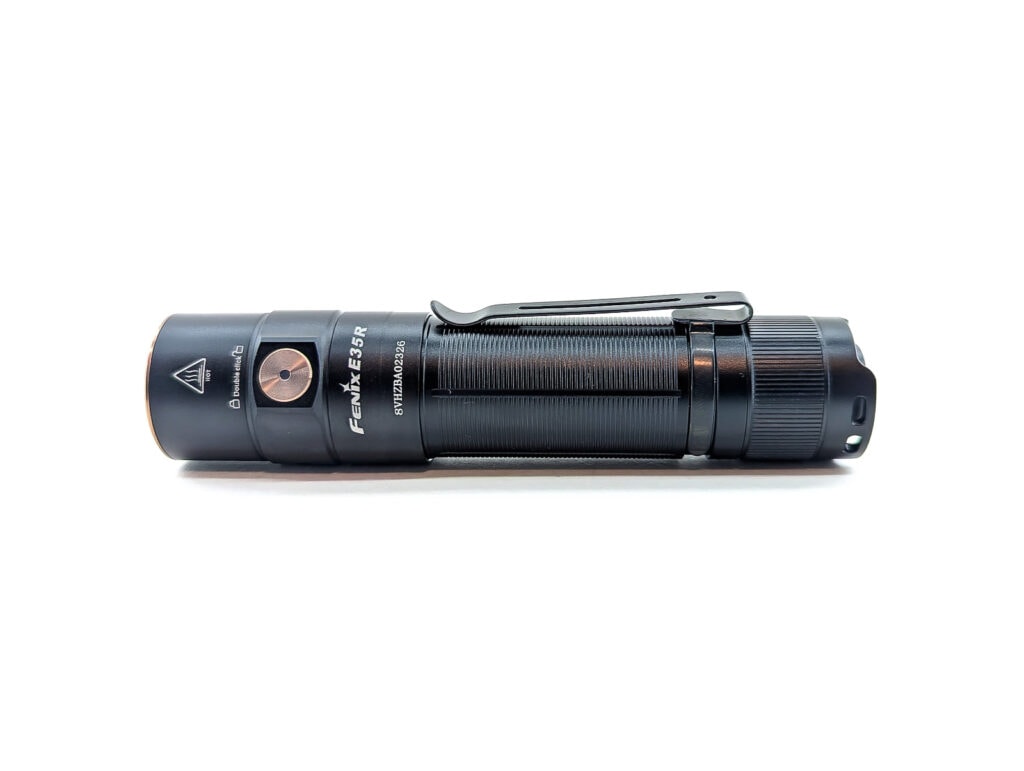
Fenix E35R specs
| Brand & Model | Fenix E35R |
|---|---|
| Flashlight category | EDC flashlight |
| LED | Luminus SST70 |
| Max. output | 3100 lumens |
| Max. beam distance | 260 meters |
| Max. beam intensity | 15,103 cd |
| Battery config. | 1x 21700 |
| Onboard charging | USB-C |
| Modes | 5 |
| Blinkies | Strobe |
| Waterproof | IP68 |
| Review publication date | May 2023 |
Review intro:
Fenix makes a huge array of lights. In fact, they have an actual PDF catalog on their website (I imagine it’s probably also distributed in paper form as well) that is 48 pages long and chock-full of products ranging from tiny EDC lights all the way up to a couple really big boys that I’ve been fortunate enough to check out: the Fenix LR50R 12,000 lumen monstrosity and the HT30R 1500m throw LEP. If you need a light, chances are that Fenix will have a nice offering to fill that need.
By and large, I really like Fenix – my first “real” flashlight was a Fenix (the 187 lumen E25 model, if you’re curious). From my experience, Fenix lights are really well designed, they use quality materials and finishes, have great constant-current drivers, and publish truthful ANSI specs. I recently reviewed the small E18R V2.0 EDC light, the small-midsize PD25R, as well as the PD36R Pro – all were very nice lights. Today I’m reviewing the new E35R, an entry in Fenix’s EDC series. There’s no “Pro” or “V#” on that model number, but it’s certainly not the first of a new series. The Fenix E35R is actually the successor to the E35 V3.0. I would bet that the “R” in the new model number is for “rechargeable” as the E35R features a USB-C port on the flashlight while the E35 V3.0 relied on a battery with a built-in charging port. That in itself is a welcome change – what else can we find out about the E35R?
Getting started with the Fenix E35R is pretty straight-foward: remove the flashlight from the box, unscrew the battery tube, and remove the little insulator disc. Put the battery & tube back on and you’re good to go!
Package quality.
The packaging for the Fenix E35R is instantly recognizable as having come off the same line as the other Fenix models that I recently reviewed. They used the exact same design language and materials: a showy black and orange carton with a heavy duty plastic tray inside. I think it’s great that Fenix is using consistent packaging as it helps drive brand recognition. Arranged in the tray was:
- Fenix E35R
- Battery
- Charging cable
- Spare o-ring
- Pocket clip (pre-installed)
- Lanyard
- Manual and other literature
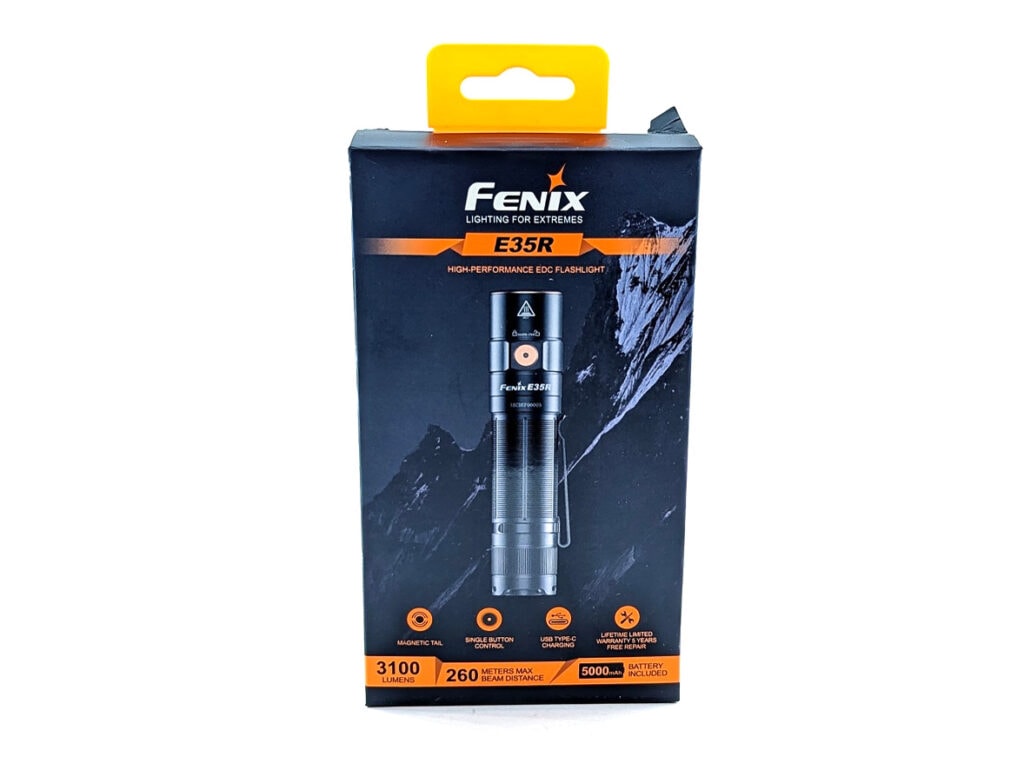
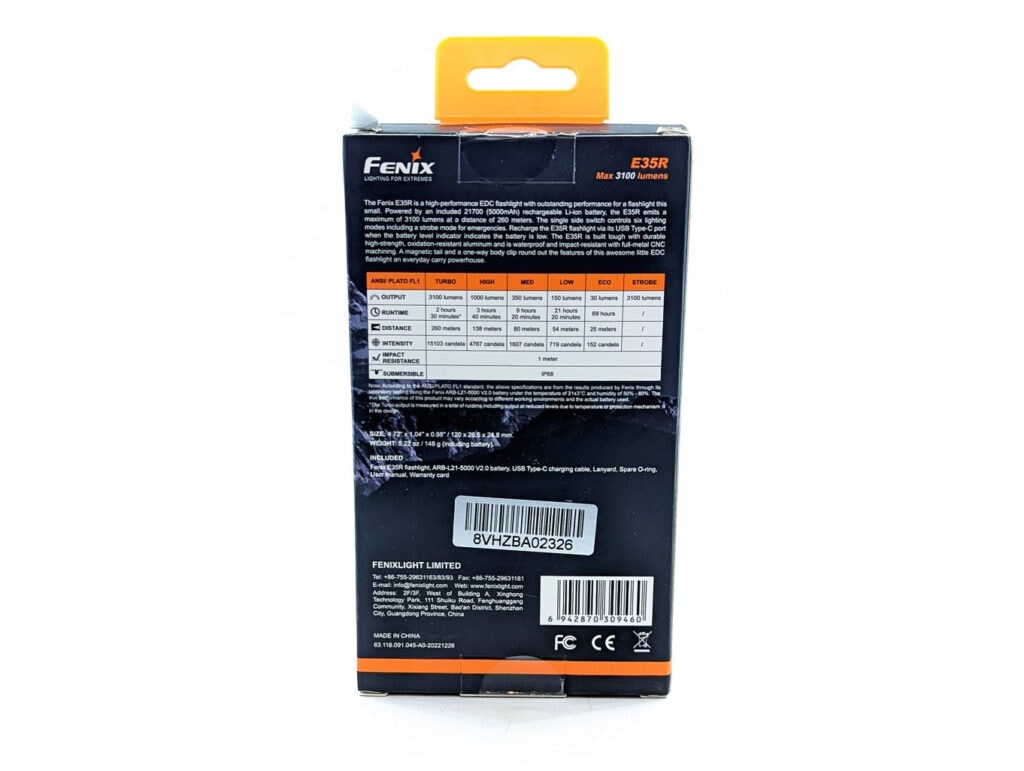
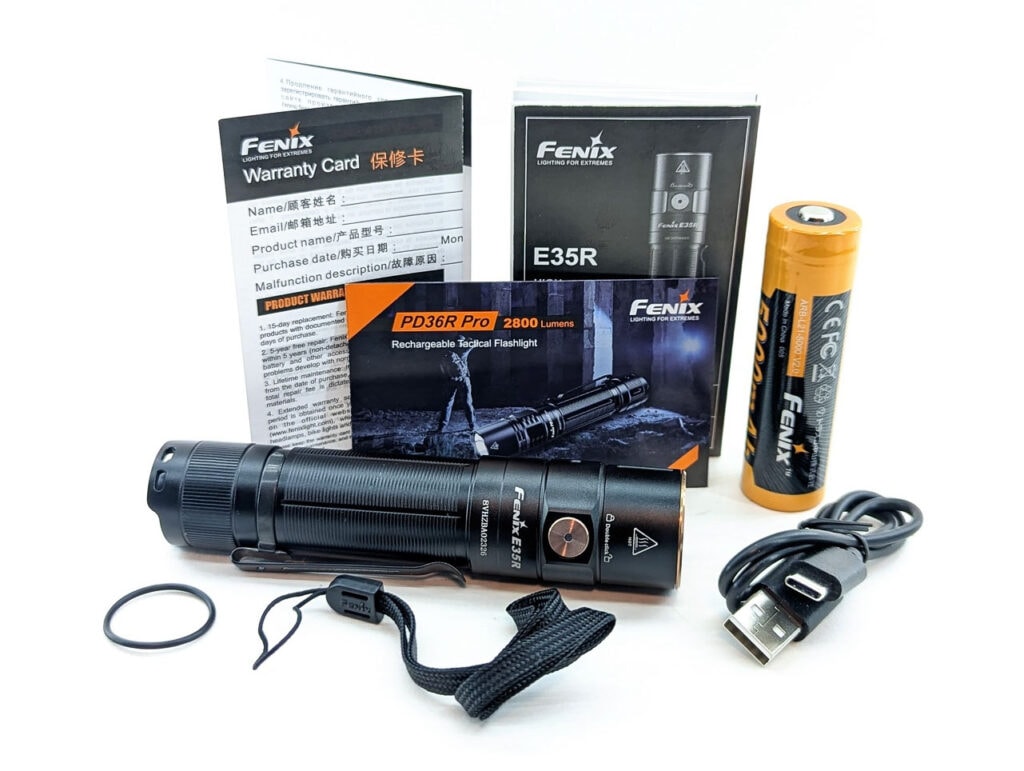
Flashlight in use
Size-wise, I consider the E35R to be very comfortable to hold and operate. I feel like 21700 lights strike a nice, happy medium on sizes and overall sit in the hand pretty well even if they tend to be too big for EDC carry (in my opinion). In terms of carry, the Fenix E35R comes with a pocket clip preinstalled. The clip is very firmly attached and should work well, though I can’t see pocket-carrying this flashlight too often – it’s on the large side of lights that I would stow away in my pocket unless I really knew I was going to need it. Fenix included a pretty standard-issue lanyard, which is nice to have on occasion.
The tail of the Fenix E35R is pretty flat and it tail-stands easily. The rear also has a strong magnet built into it, so the E35R is easy to position on ferrous surfaces like a car hood or appliance.
Like most other E-series lights from Fenix, the E35R features a single e-switch aside of its head. The switch is seated in a bumped out area that helps you find it without looking. And while it’s quite flush with the bumped out area, the button is still easy to press when you’re intending to do so.
The Fenix E35R is a nice EDC-style light. It’s appropriate for all sorts of uses like hiking, dog walking, in the house/garage, etc. While the E35R is incredibly useful, don’t mistake it for a tactical light. Those feature purpose-built UI’s and usually a dual-switch configuration, such as you’ll find on the Fenix PD36R.
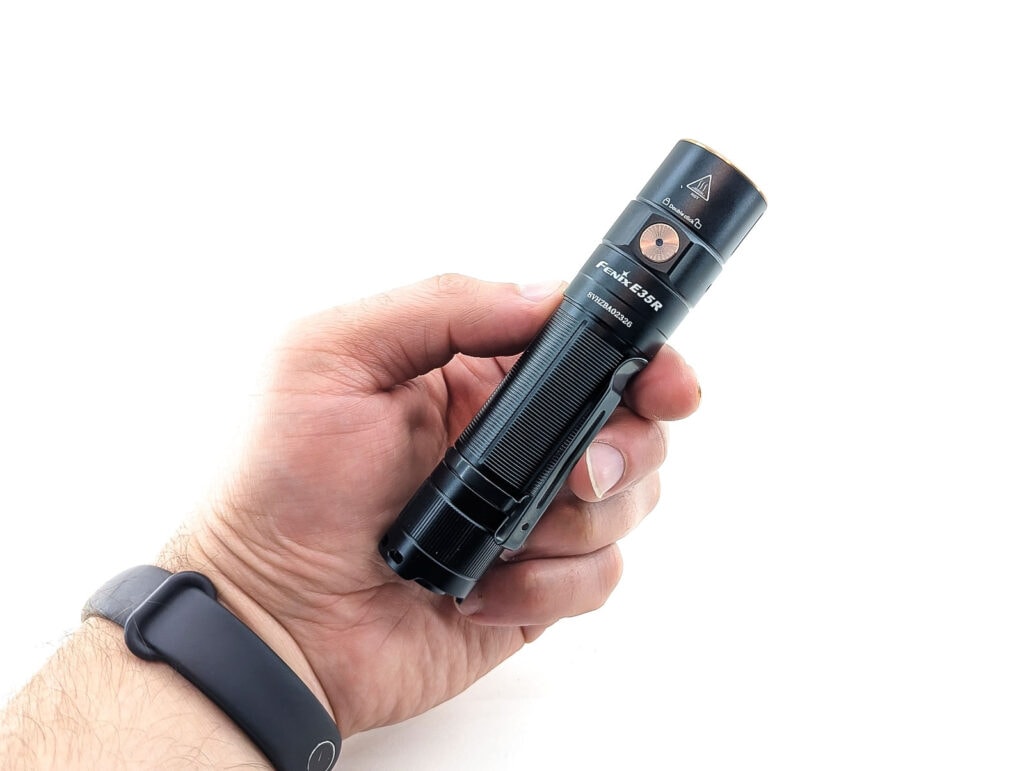
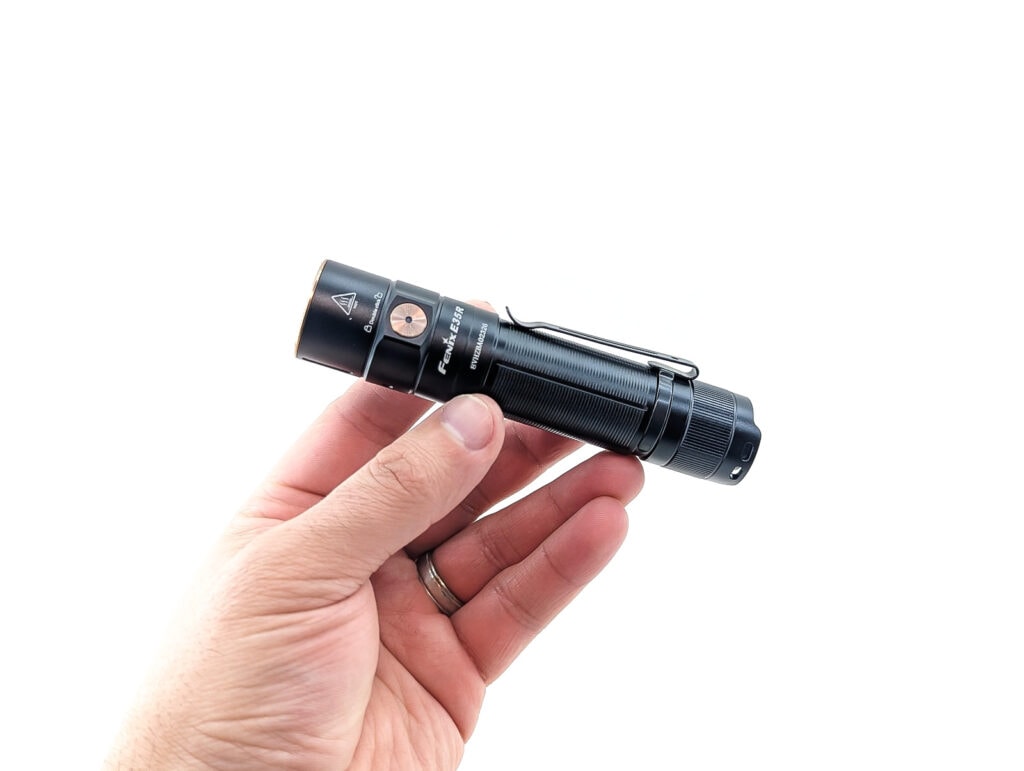
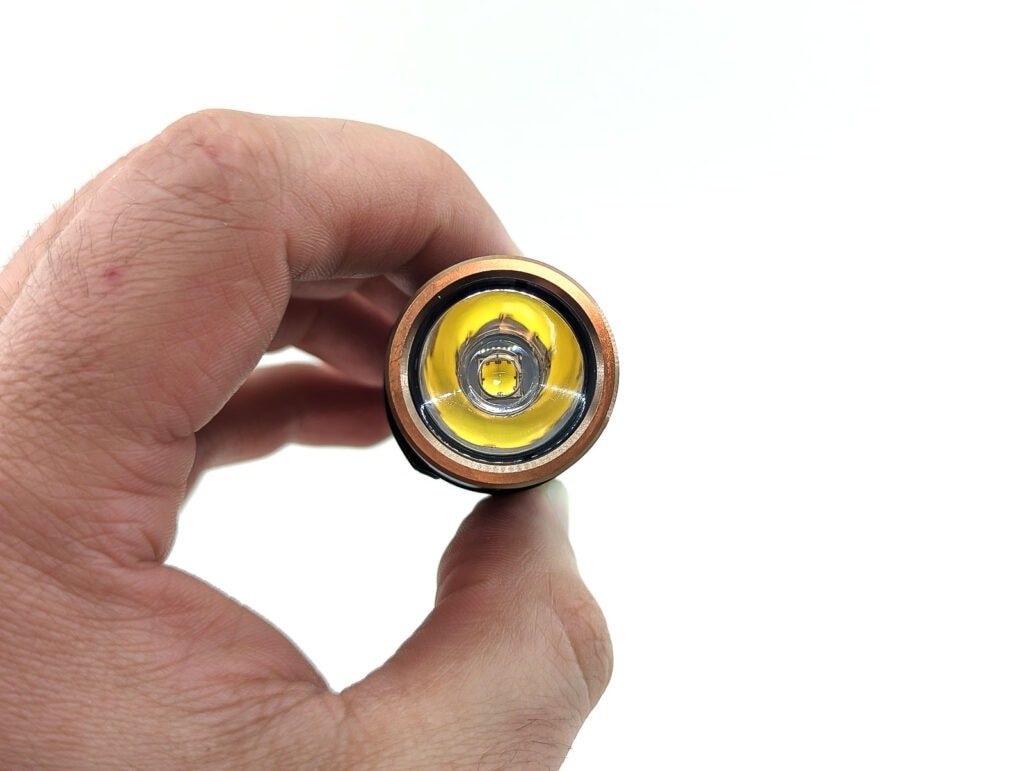
Build Quality and Warranty
Fenix used A6061-T6 aluminum in the construction of the E35R, then coated it in premium type III hard anodizing. The fit and finish look absolutely great, as I’ve come to expect from Fenix. There’s no knurling to speak of. There are tiny grooves machined into the battery tube but they don’t provide much grip.
Warranty:
- 15 days from date of purchase: replacement from Fenix for manufacturing defects
- 5 year from date of purchase: free repairs
- Lifetime maintenance, with customer covering the cost of parts
- Extra 6 month warranty period for products registered on Fenix’s website
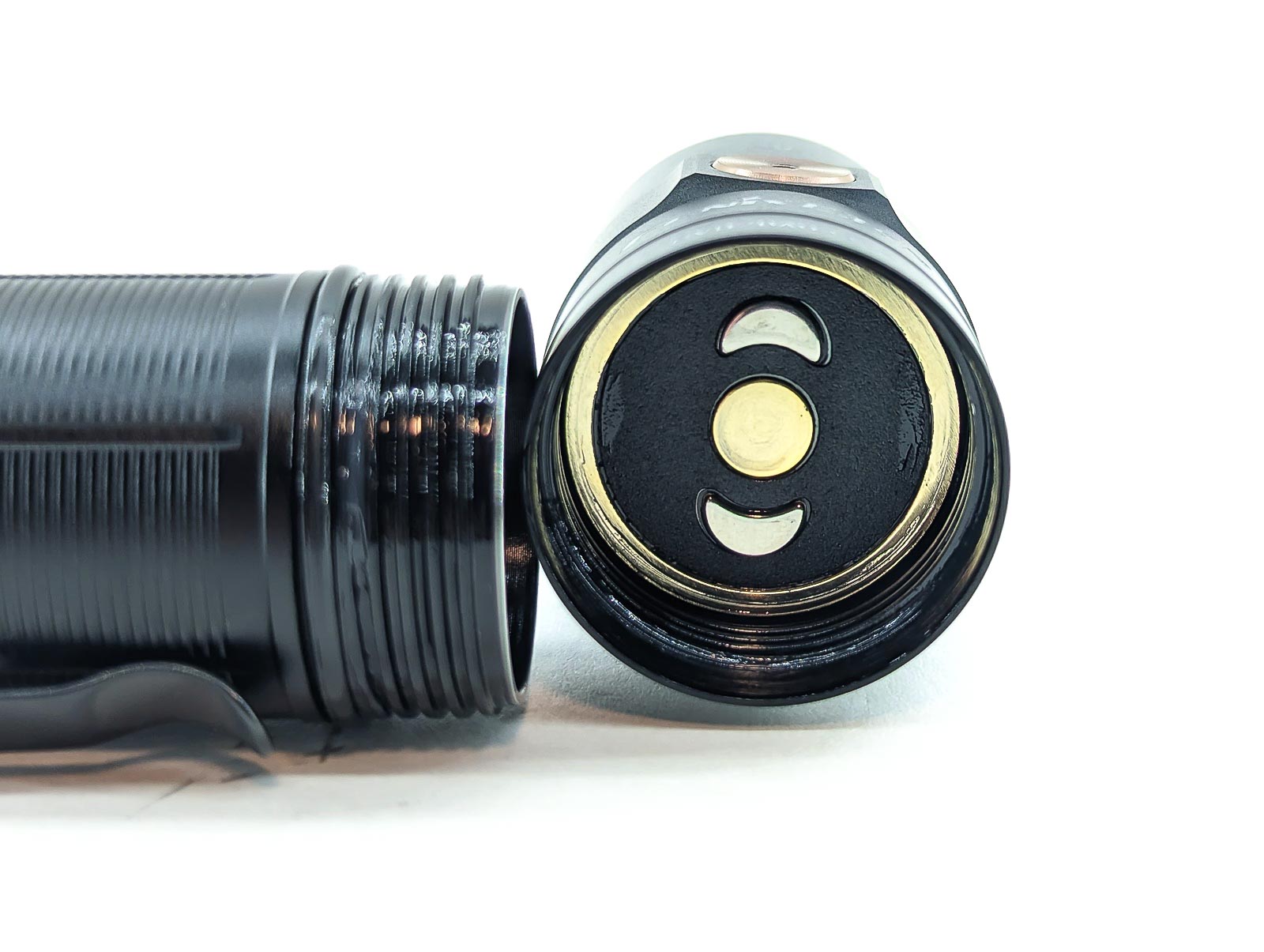
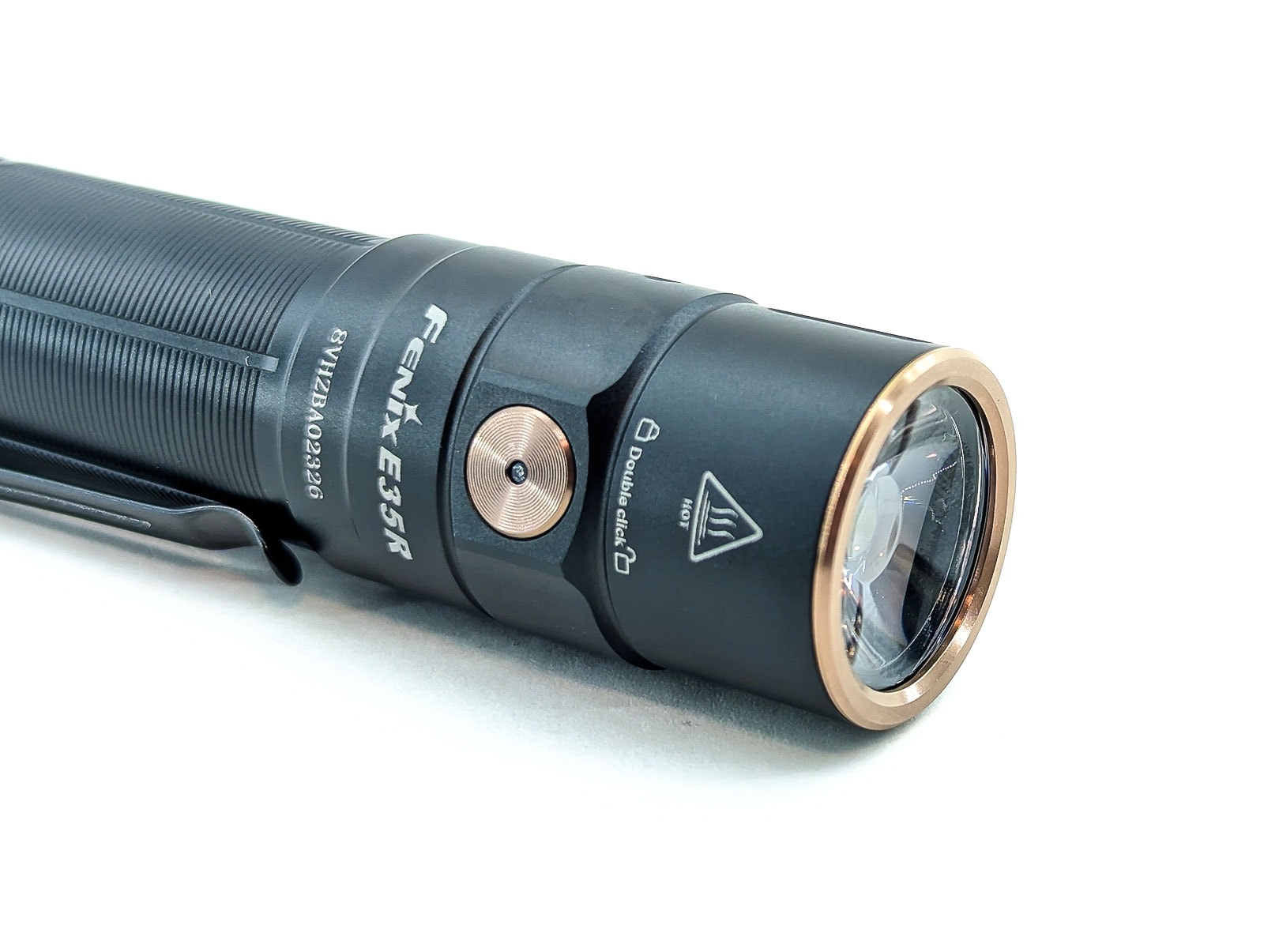
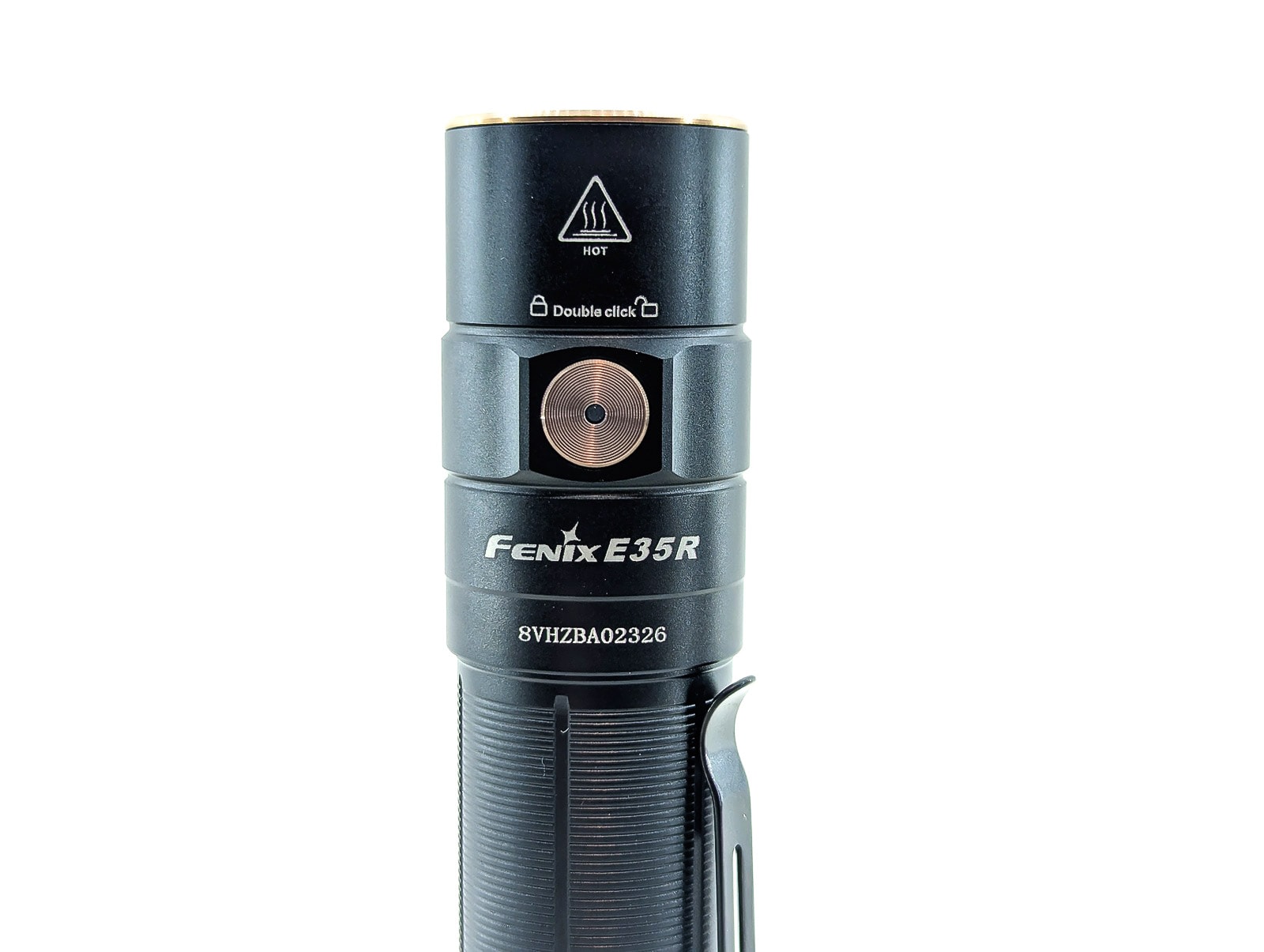
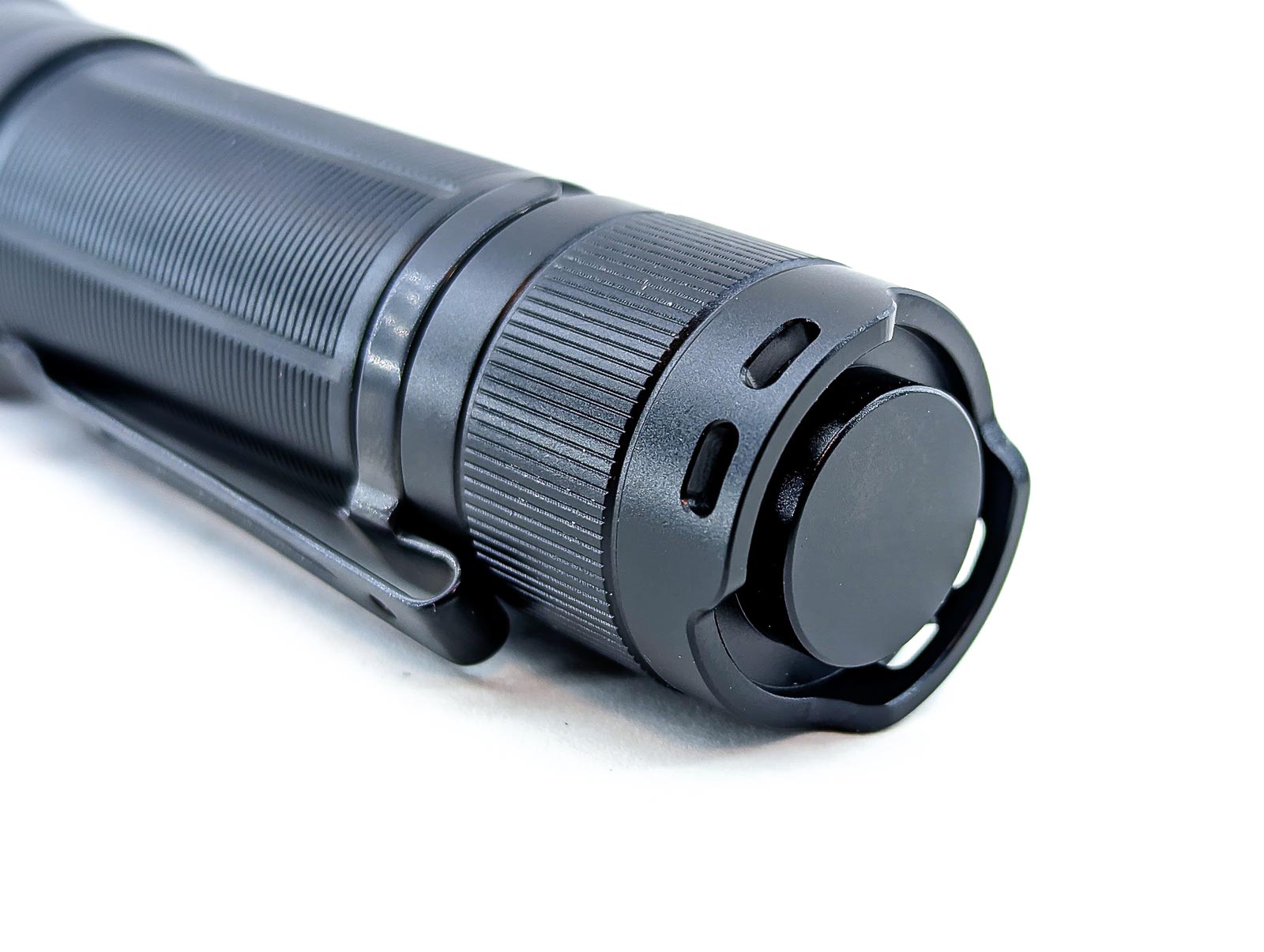
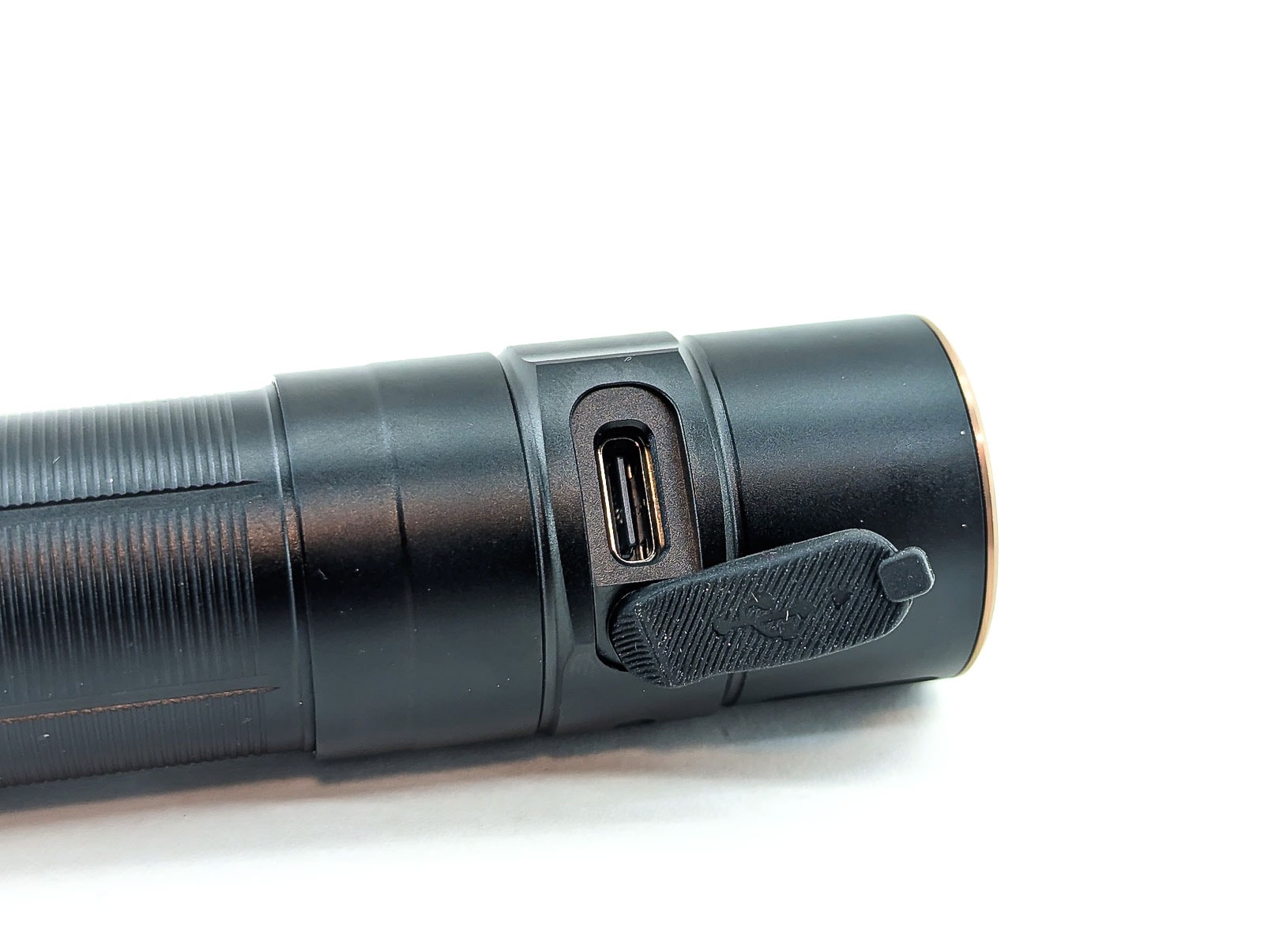
LED, Lens, Bezel, Beam, and Reflector
Fenix went with a Luminus SST70 LED for the E35R. This isn’t an LED that I see much of, but I do remember running across it in the beastly Fenix LR50R. It’s a lot like the well-known SST40 – it retains the same 5050 footprint and a similar physical appearance, but it’s a quad-die LED and runs at 6V or 12V. According to Luminus, the LED is capable of producing 3380 lumens or more. The LED is nicely centered in a clear TIR optic. The optic produces a clearly defined hotspot and wide spill.
I got the following measurements of the center of the beam with my Opple Light Master at 3 meters with the Fenix being on Turbo:
- CCT: 5828K
- CRI: 66.8 Ra
- DUV: +0.0082
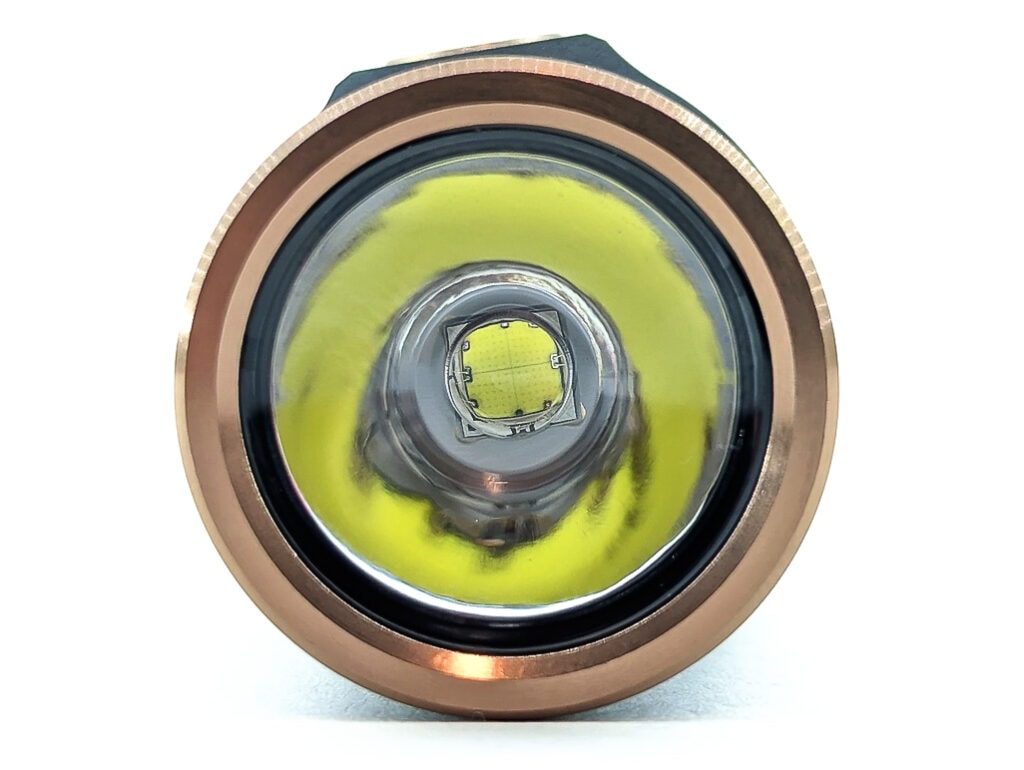
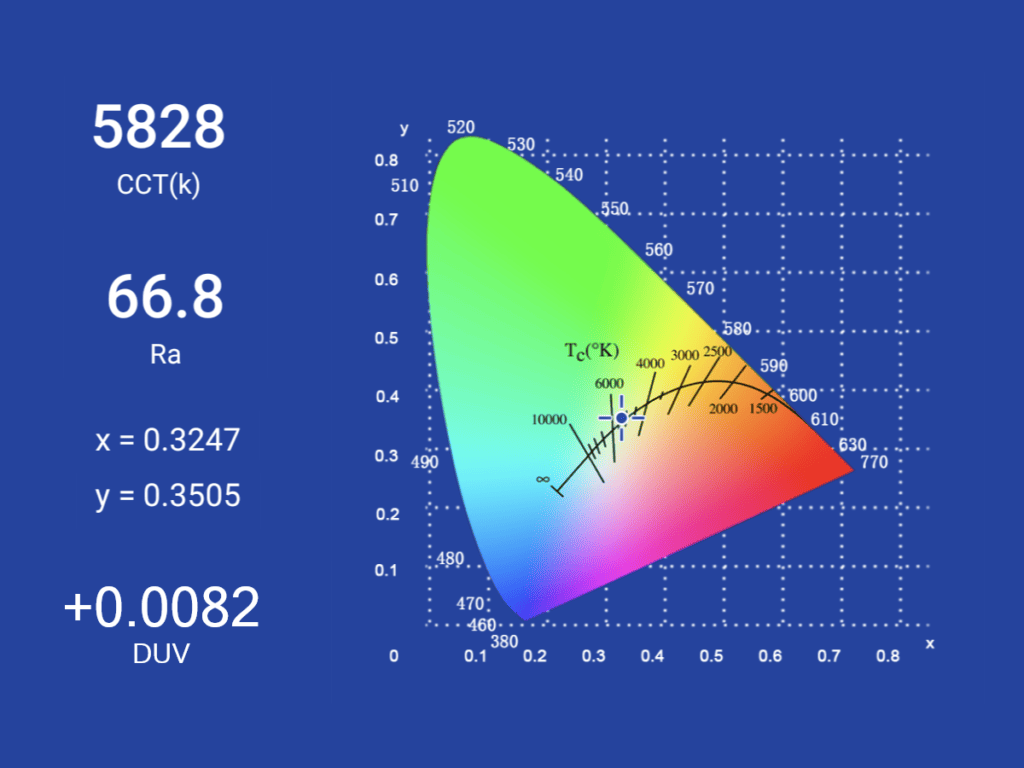
Dimensions and its competition
Dimensions:
| Fenix E35R | Millimeters | Inches |
|---|---|---|
| Length | 120 mm | 4.7 in |
| Head diameter | 27 mm | 1.0 in |
| Body diameter | 25 mm | 1.0 in |
Dimensions are rounded to the nearest millimeter, and to the nearest tenth of an Inch.
Weight:
| Fenix E35R | Weight in grams | Weight in oz |
|---|---|---|
| Without battery: | 74 g | 2.6 oz |
| With battery | 147 g | 5.2 oz |
Weight is rounded to the nearest gram, and to the nearest tenth of an Oz.
Flashlight size comparison with its competition:
Group 1: Fenix PD36R Pro, Fenix E35R, Fenix E-CP
Group 2 EDC flashlights: Fenix E35R, Sofirn SP35, Astrolux ST01, Convoy S21D
Group 3: Olight Baton 3 Pro Max, Fenix E35R
Make sure you also check out our other Fenix flashlight reviews
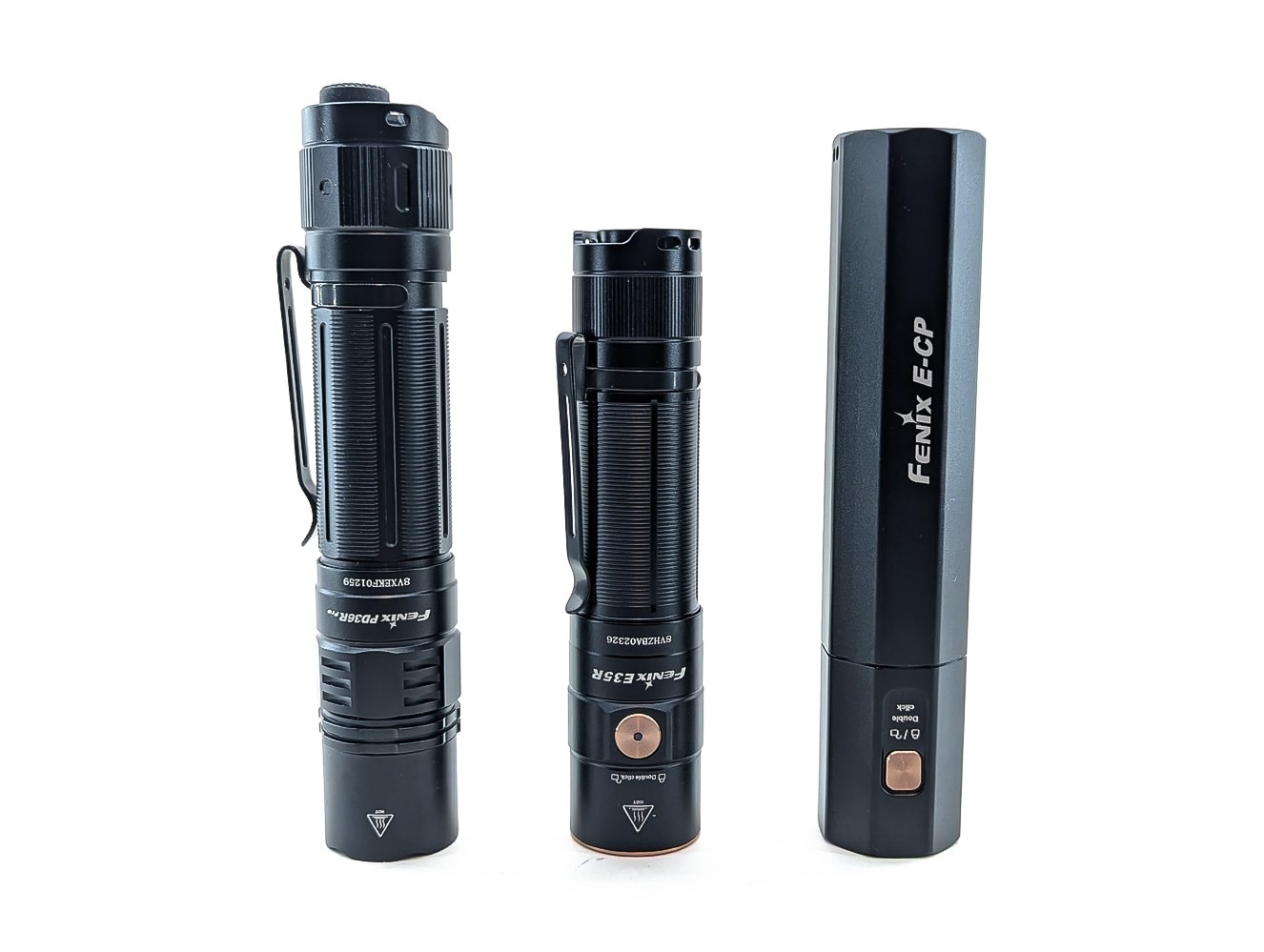
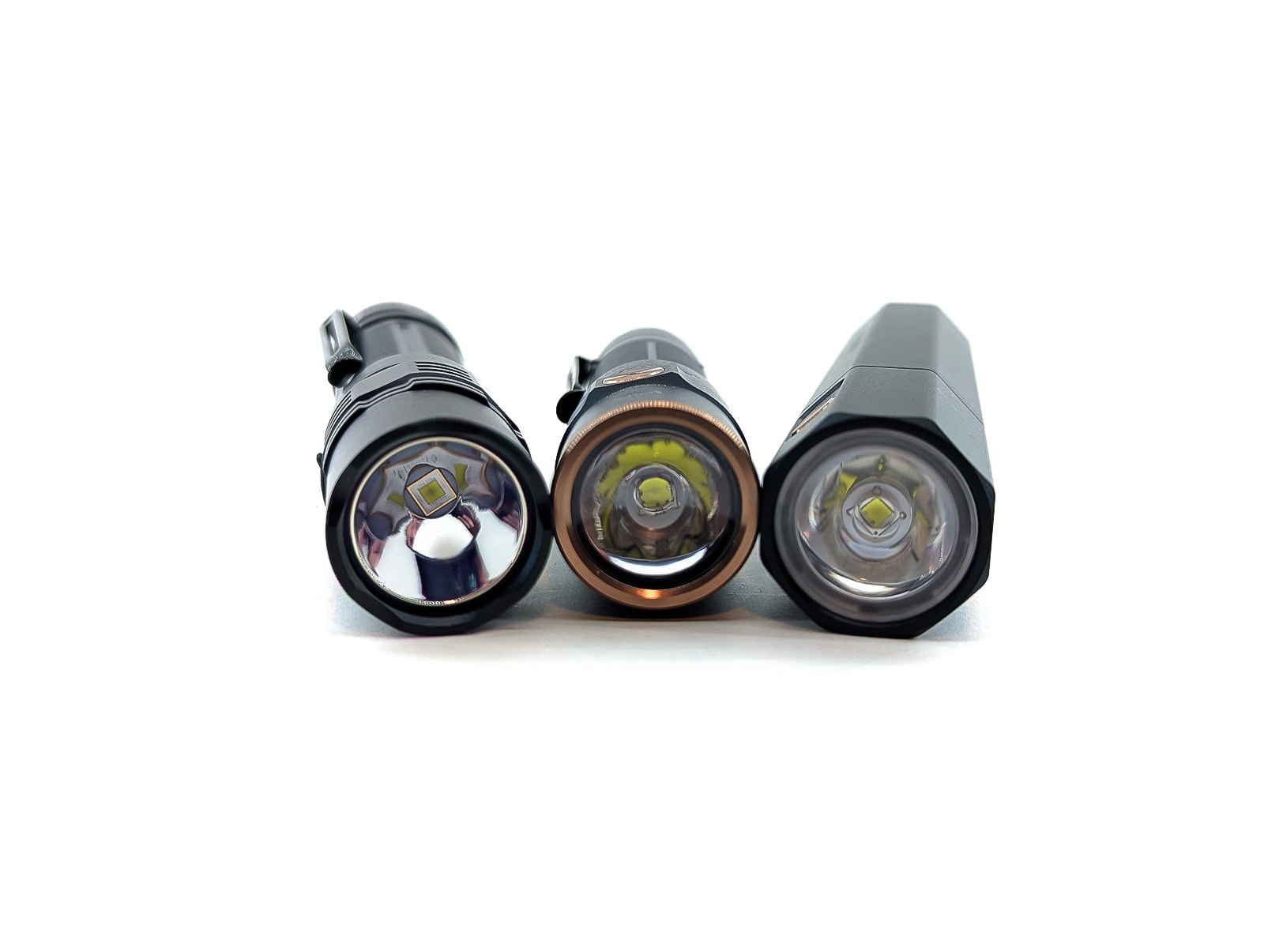
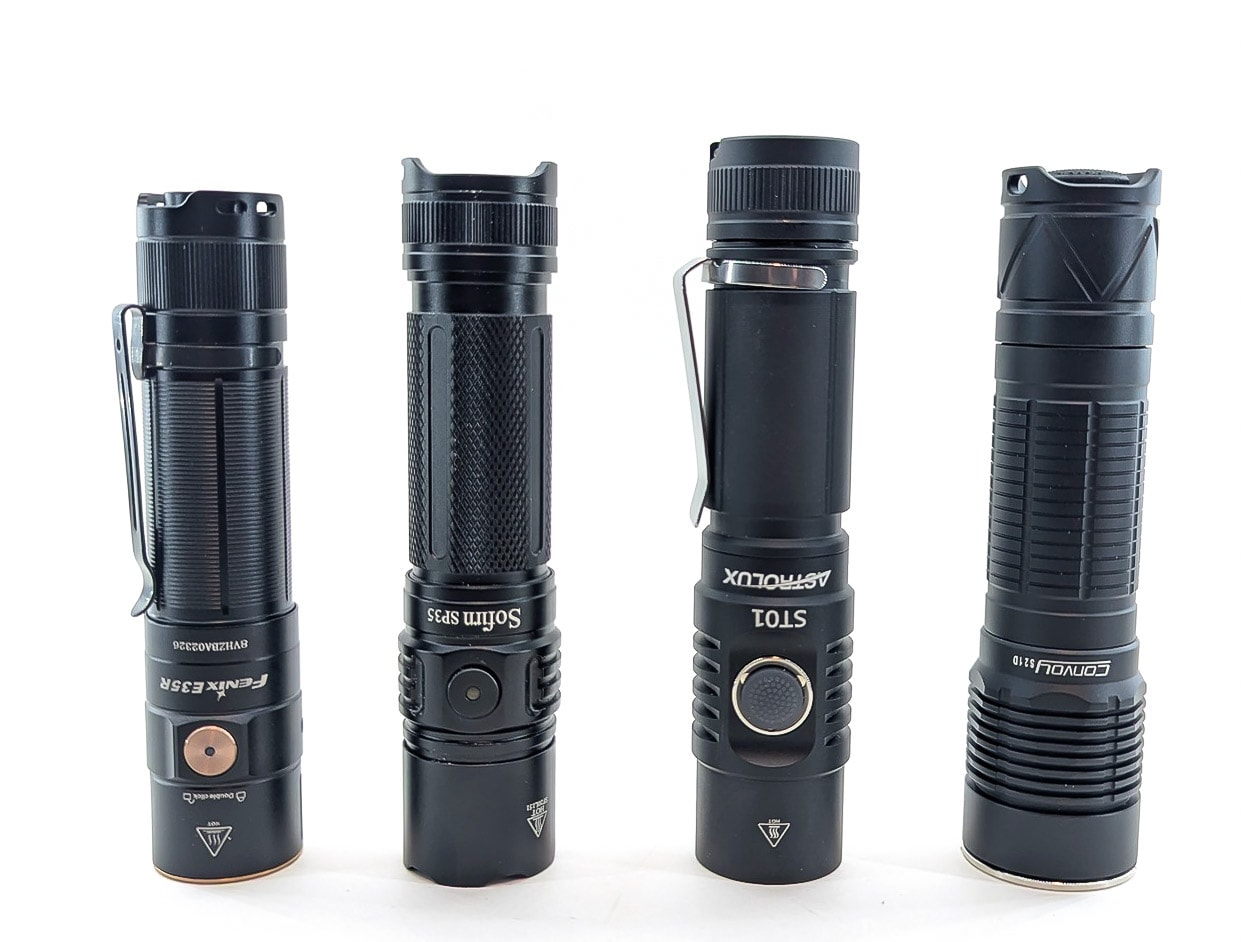
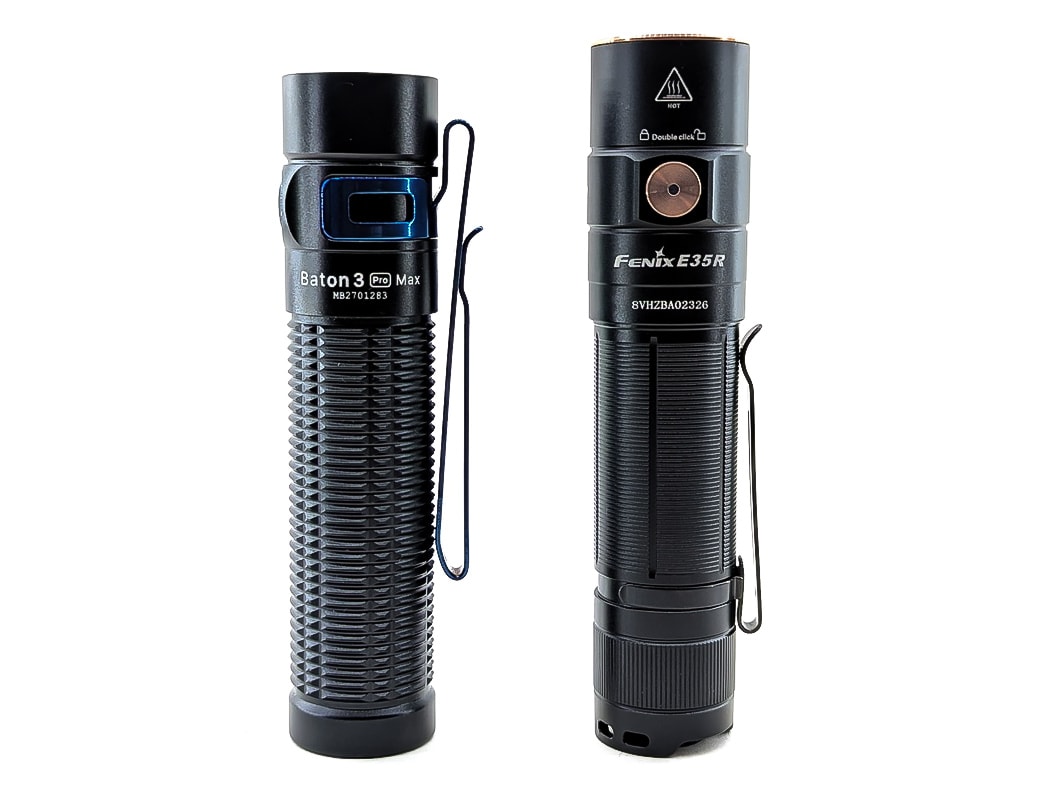
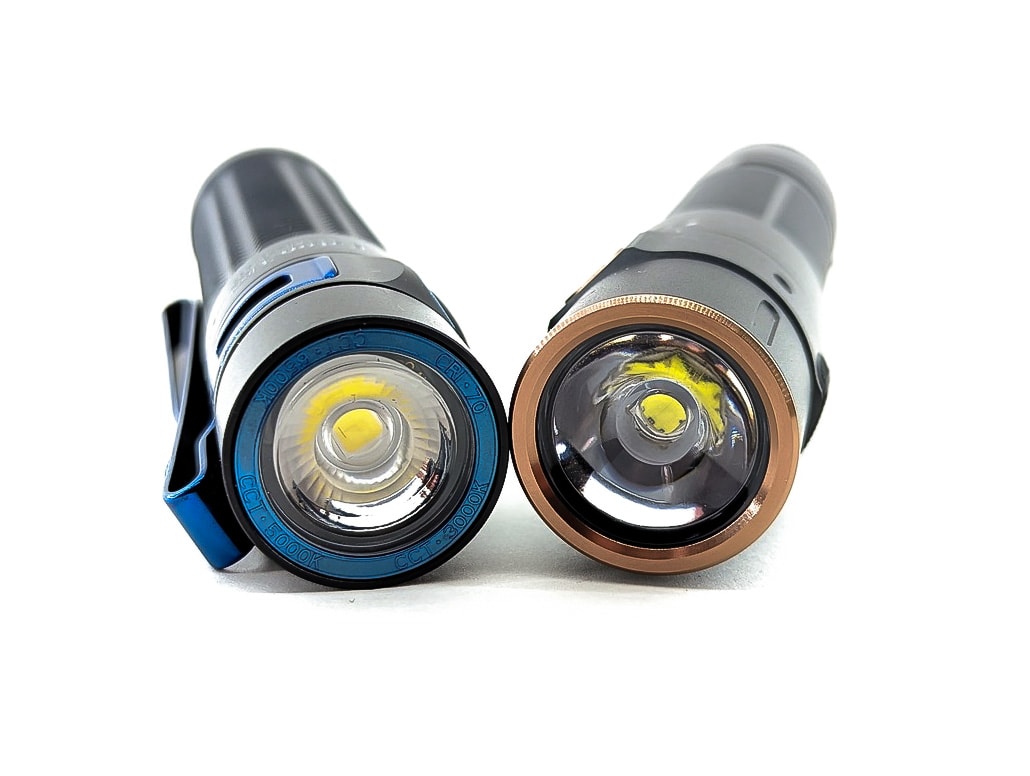
Fenix E35R UI: User Interface and Driver
The UI that Fenix uses on their single-switch E-series lights isn’t my personal favorite, but at least I think it’s pretty consistent. In short, it’s a short-hold for On and Off. I think that’s because it should be more difficult to accidentally activate in your pocket that way. That makes sense, but I think that accidentally holding the button down for a moment in your pocket is also a likely scenario, so I’m not sure it really helps that much. Making the electronic lockout easy to activate was a good move though.
Available modes:
- Eco, Low, Medium, High, Turbo
Available blinky modes:
- Strobe
From OFF:
- Press and Hold 0.5 sec: turn on (last used mode)
- Press and Hold 1.2 sec: Strobe
- Double click: lockout
From ON:
- Press and Hold 0.5 sec: turn off
- Press and Hold 1.2 sec: Strobe
- 1 click: change brightness
Mode memory:
- Yes, it has mode memory
- Turbo, High, and Strobe will not be memorized
- When turning the light off in Turbo or High mode, it will revert to Medium mode
Shortcuts:
- To Strobe: hold the switch 1.2 sec from either On or Off
Low voltage warning:
- When the battery voltage gets low, output will step down until it reaches Moonlight (at which point the indicator LED will start flashing red)
- There is a battery indicator LED in the middle of the switch that activates for 3 seconds when you turn the light on:
- Green solid: 100-85%
- Green flashing: 85-50%
- Red solid: 50-25%
- Red flashing: 25-1%
Strobe/blinkies
- There is a Strobe mode that can be access with a long hold (1.2 seconds) from either On or Off
Lock-out mode:
- Yes, double click from Off to activate electronic lockout. Double click again to exit.
PWM
- There is no PWM
Additional/summary info on the UI:
- There is “intelligent overheat protection” that reduces output to keep the temperature at or below 60°C
- Like I said in the intro to the UI section, the Fenix e-switch UI isn’t my favorite, but if you’re used to the UI from other Fenix lights (like my trusty E25), you’ll feel right at home.
Fenix E35R Charging and batteries
The E35R comes with a Fenix-branded cell, the ARB-L21-5000 V2.0. It is not a proprietary battery, just a button-top 5000 mAh 21700 battery with a protection circuit. I tried a flat-top Samsung 50E battery and a Molicel P42A battery; they were too short to make contact. That, and it looks like a button-top battery is required. So, I tried a solder-blobbed 40T – it worked! Protected cells are definitely recommended for the E35R; thankfully Fenix included a nice one in the box. But a button-top 21700 will likely work if you’re in a pinch.
The Fenix E35R has built-in USB-C charging via a port on the side of the head which is covered up by a typical rubber dust plug. Fenix says that a fully depleted battery should take 3 hours to recharge. While charging, the indicator LED will illuminate red, then switch to green when charging is complete. In my testing, I observed a 7.98 watt charge rate (1.55A at 5.13V) and the cycle completed in 3 hours 1 minute.
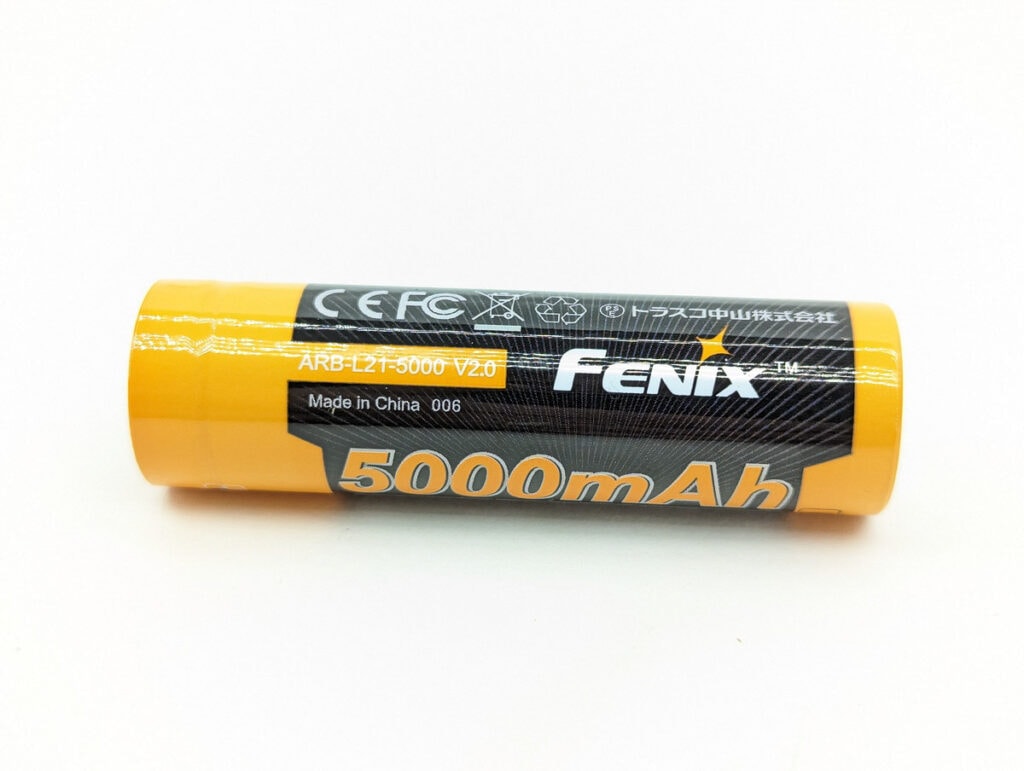
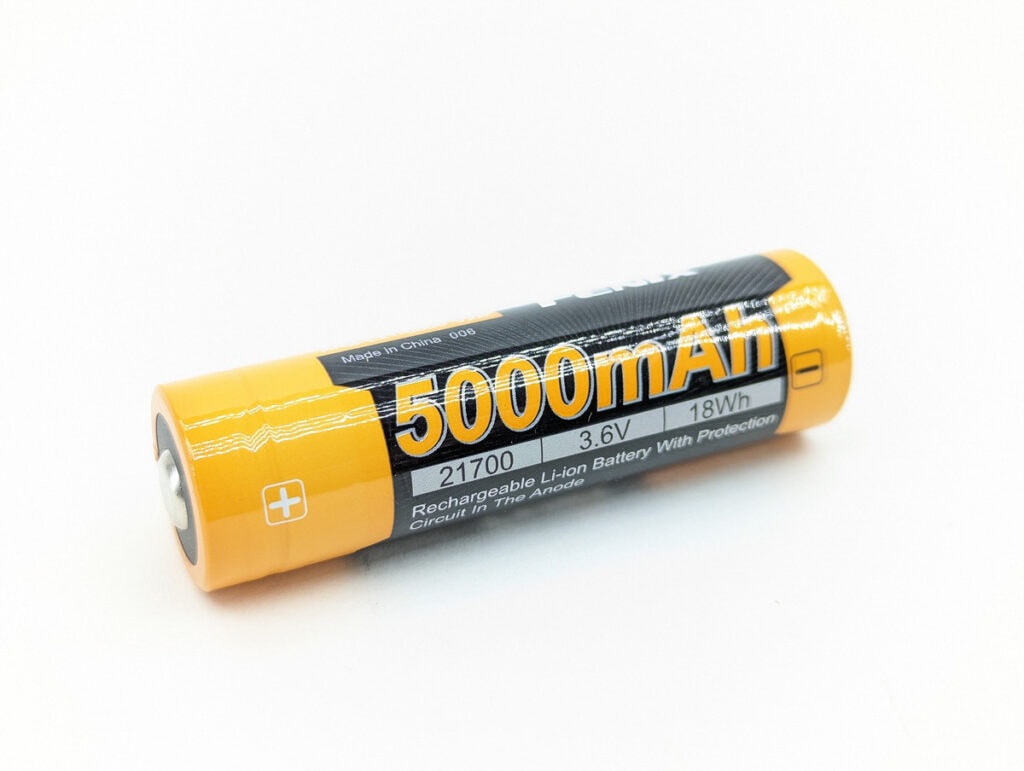
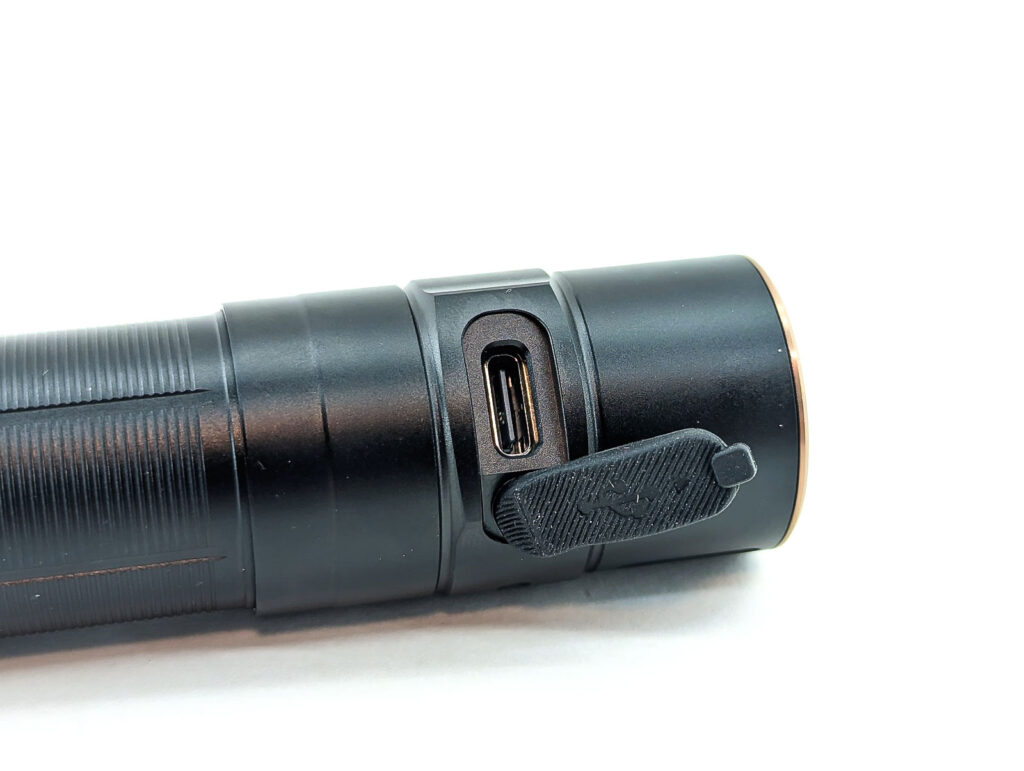
Performance test
Lumen measurements
How Lumens are Measured: Understanding ANSI FL1 Standards How Lumens are Measured: Understanding ANSI FL1 Standards: The ANSI FL1 standards specify that output in lumens should be measured 30 seconds after turning on, as this is the standardized time for measuring brightness according to the industry standard. This is why we focus on this part in our measurements. The ANSI FL1 standards require an ambient temperature of 22 ± 3°C. We record the ambient the ambient temperature to identify potential reasons for any observed discrepancies.Lux was measured by a UNI-T UT383 BT at 5 meters. Lumens were measured in a homemade lumen tube using a VEML7700 sensor, calibrated with a calibration light provided by 1Lumen. The included Fenix battery was used for testing..
| Mode | Specified | turn on | 30 sec | 10 minutes |
|---|---|---|---|---|
| Eco | 30 | 31 lm | 31 lm | – |
| Low | 150 | 168 lm | 168 lm | – |
| Med | 350 | 397 lm | 396 lm | 395 lm |
| High | 1000 | 1162 lm | 1139 lm | 1104 lm |
| Turbo | 3100 | 3477 lm | 2772 lm | 1141 lm |
| Turbo at 3.6V | – | 2093 lm | 1917 lm | – |
Parasitic drain:
- 34 µA
In general, I would say that my results line up closely with Fenix’s claims. However, my 30 second reading in Turbo is lower than spec, despite starting out well above the 3100 lumen claim. This is likely a result of the thermal regulation, as the exterior of the light was at 58°C by 30 seconds. Which is understandable for a compact and lightweight 3100 lumen flashlight.
Side note: the tailcap is part of the battery tube (either glued or machined as one piece), so taking current readings wasn’t very feasible, so those have been omitted.
Fenix E35R Battery Life: Runtime graphs
How Runtimes are Measured: Understanding ANSI FL1 Standards About ANSI FL1 runtime standards: The runtime is measured until the light drops to 10% of its initial output (30 seconds after turning on). This does not mean that the flashlight is not usable anymore. The last column shows how long the light actually works till it shuts off. If there is a + symbol, it means that the test was stopped at that particular point, but the light was actually still running. This happens on certain occasions, with certain drivers, firmware, or batteries.| Mode | Specified | Measured runtime ANSI | Time till shut off |
|---|---|---|---|
| Eco | 69h | – | – |
| Low | 21h 20min | – | – |
| Med | 9h 20min | 8h 43min | 10h 39min |
| High | 3h 40min | 3h 37min | 6h 30min |
| Turbo | 2h 30min | 2h 32min | 6h 14min |
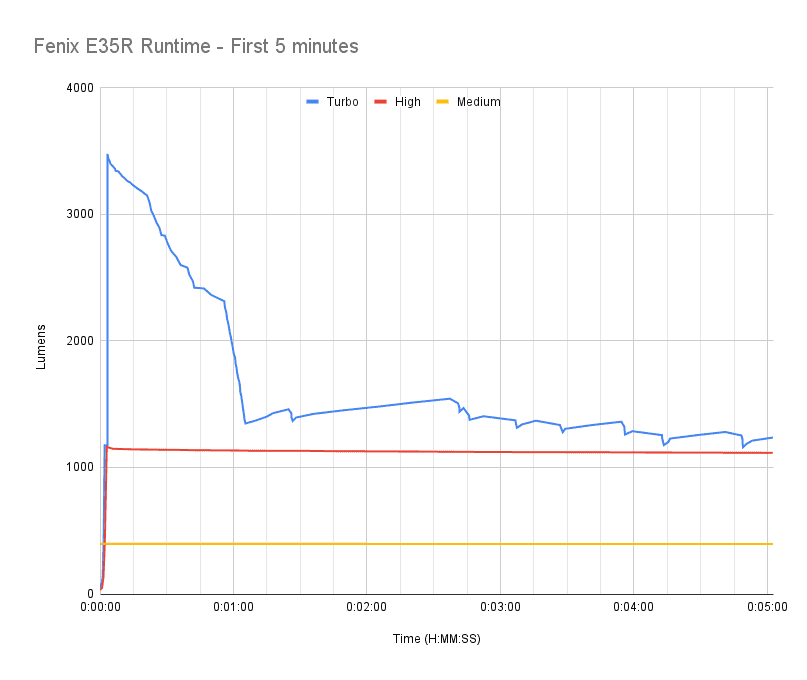
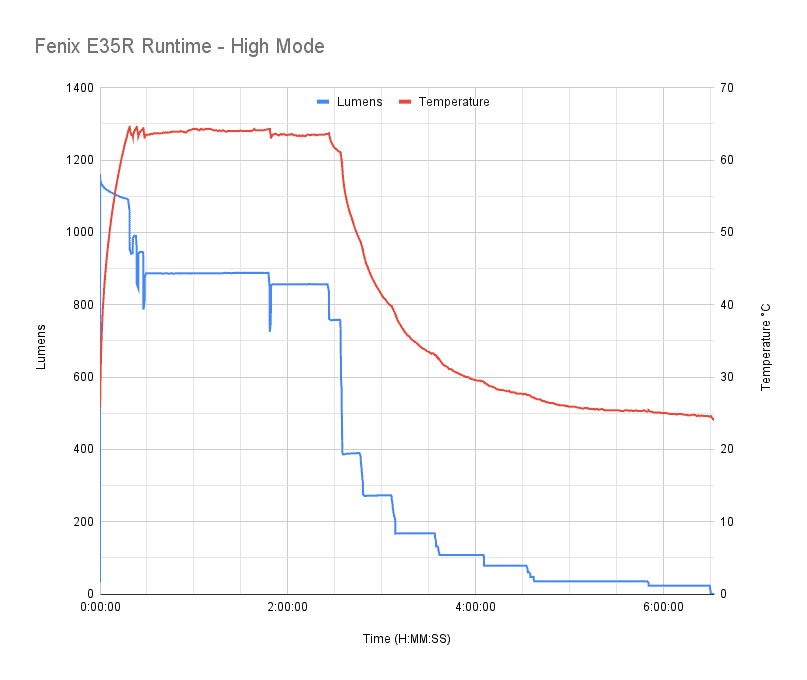
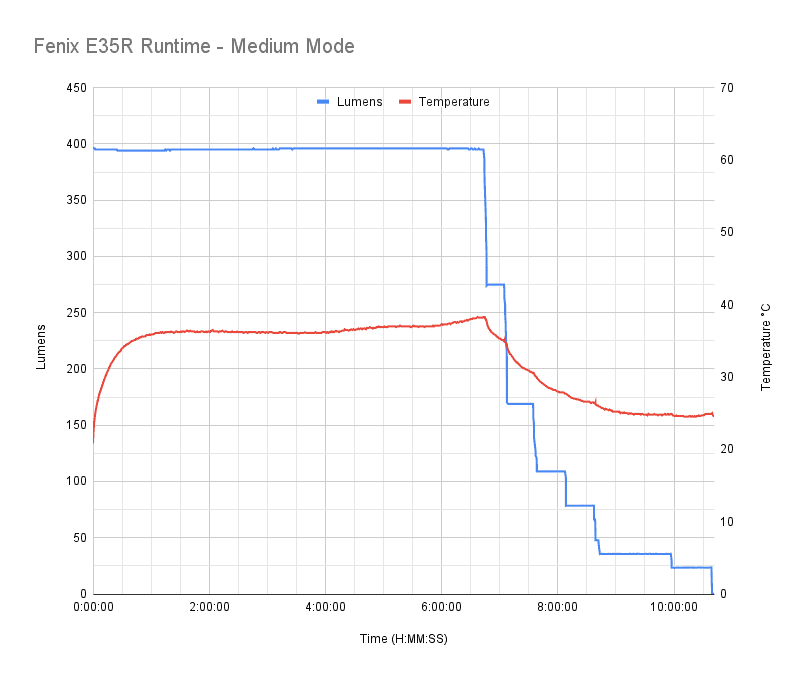

Peak beam intensity and beam distance measurements
About Peak beam intensity: Understanding ANSI FL1 Standards About peak beam intensity The calculated value of distance in meters at which the flashlight produces a light intensity of 0.25 lux. (0.25 lux is about the brightness of a full moon shining on an object). This means that the intensity has decreased so much, it becomes difficult to see darker objects, or objects that don’t reflect light. The columns ‘Meters’ and ‘Yards’ use rounded numbers.Intensity was measured at 5 meters after being turned on for 30 seconds. Since candela values for the Eco and Low modes were relatively low, those were measured at 2 meters. A UNI-T UT383 BT lux meter was used.
| Mode | Specified | Candela measured | Meters | Yards |
|---|---|---|---|---|
| Eco | 152 cd | 160 cd | 25 m | 28 yd |
| Low | 719 cd | 712 cd | 53 m | 58 yd |
| Medium | 1,607 cd | 1,725 cd | 83 m | 91 yd |
| High | 4,767 cd | 5,075 cd | 142 m | 156 yd |
| Turbo | 15,103 cd | 15,775 cd | 251 m | 275 yd |
No surprises here – my measurements line up very well with Fenix’s specs.
Beamshots
Beam shots of the building are taken at 30 m (33 yd) using a Pixel 7 set to ISO 800 with 1/10 second exposure time
Beamshots of the following flashlights compared:
- Fenix E35R
- Olight Baton 3 Pro Max
- ThruNite TC20 Pro



Disclaimer: This flashlight was sent to me for review at no cost by Fenix Lighting US. I have not been paid to review, nor have I been holding back on problems or defects.
Final Verdict
Pros
- Great build quality
- Excellent regulation
- USB-C charging
- Magnetic tail
Cons
- No shortcuts for Eco or Turbo modes
- Thermal throttling takes makes Turbo miss lumen spec
- No moonlight mode
Explanation on star ratings:
1: Avoid: a match would be a better choice – 2: Poor: significant defect or issues; almost unusable – 3: Average: some defects or issues; but still usable 4: Good: recommended (minor issues) – 5: Great: highly recommended

4.5 stars: ★★★★⋆
While our star rating provides a reliable indicator, we encourage you to read the full review to make an informed decision based on your own needs and preferences.
The E35R is the latest version of Fenix’s E35 series, now with built-in USB-C charging, which is a big plus. This flashlight exhibits all of the top-notch fit & finish that I’ve come to expect from Fenix. It is definitely a part of the E (EDC) series, as it only has a single e-switch. For those that have used Fenix’s EDC UI before, it’s pretty straight-forward, but a bit limited. In an EDC, I would love to see dedicated shortcuts to Eco and Turbo. That’s really my biggest gripe with the Fenix E35R – no shortcuts. UI aside, all of the physical aspects of the E35R are really solid.
Buy your Fenix E35R with a discount
Get 10% off every purchase at Fenix Lighting US, by using our exclusive 1lumen discount code: 1lumen10
1lumen selects and reviews products personally. We may earn affiliate commissions through our links, which help support our testing.